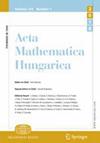一类莫兰测度在平面上的频谱性
IF 0.6
3区 数学
Q3 MATHEMATICS
引用次数: 0
摘要
让 \(\{(R_k,D_k)\}_{k=1}^\infty\) 是对的序列,其中 $$D_k=\{0,1,\ldots,q_k-1\}(1,1)^T$$ 一个整数向量集合和吗 \(R_k\) 是整数对角矩阵或上三角矩阵,即\(R_k={\begin{pmatrix} s_k & 0\\ 0 & t_k \end{pmatrix}}\)或\(R_k={\begin{pmatrix} u_k & 1\\ 0 & v_k \end{pmatrix}}\).与序列相关联 \(\{(R_k,D_k)\}_{k=1}^\infty\) ,莫兰测度 \(\mu_{\{R_k\},\{D_k\}}\) 定义为$$\mu_{\{R_k\},\{D_k\}}=\delta_{R_{1}^{-1}D_{1}}\ast\delta_{R_{1}^{-1}R_{2}^{-1}D_{2}}\ast\cdots\ast \delta_{R_{1}^{-1}R_{2}^{-1}\cdots R_{k}^{-1}D_{k}}\ast \cdots.$$在本文中,我们考虑 \(\mu_{\{R_k\},\{D_k\}}\). 我们证明 \(\mu_{\{R_k\},\{D_k\}}\) 光谱测量在一定条件下是什么 \((R_k,D_k)\)的傅里叶基 \(L^2(\mu_{\{R_k\},\{D_k\}})\).本文章由计算机程序翻译,如有差异,请以英文原文为准。
Spectrality of a class of Moran measures on the plane
Let \(\{(R_k,D_k)\}_{k=1}^\infty\) be a sequence of pairs, where
$$D_k=\{0,1,\ldots,q_k-1\}(1,1)^T$$
is an integer vector set and \(R_k\) is an integer diagonal matrix or upper triangular matrix, i.e., \(R_k={\begin{pmatrix} s_k & 0\\ 0 & t_k \end{pmatrix}}\) or \(R_k={\begin{pmatrix} u_k & 1\\ 0 & v_k \end{pmatrix}}\). Associated with the sequence \(\{(R_k,D_k)\}_{k=1}^\infty\) , Moran measure \(\mu_{\{R_k\},\{D_k\}}\) is defined by
$$\mu_{\{R_k\},\{D_k\}}=\delta_{R_{1}^{-1}D_{1}}\ast\delta_{R_{1}^{-1}R_{2}^{-1}D_{2}}\ast\cdots\ast \delta_{R_{1}^{-1}R_{2}^{-1}\cdots R_{k}^{-1}D_{k}}\ast \cdots.$$
In this paper, we consider the spectrality of \(\mu_{\{R_k\},\{D_k\}}\). We prove that \(\mu_{\{R_k\},\{D_k\}}\) is a spectral measure under certain conditions in terms of \((R_k,D_k)\), i.e., there exists a Fourier basis for \(L^2(\mu_{\{R_k\},\{D_k\}})\).
求助全文
通过发布文献求助,成功后即可免费获取论文全文。
去求助
来源期刊
CiteScore
1.50
自引率
11.10%
发文量
77
审稿时长
4-8 weeks
期刊介绍:
Acta Mathematica Hungarica is devoted to publishing research articles of top quality in all areas of pure and applied mathematics as well as in theoretical computer science. The journal is published yearly in three volumes (two issues per volume, in total 6 issues) in both print and electronic formats. Acta Mathematica Hungarica (formerly Acta Mathematica Academiae Scientiarum Hungaricae) was founded in 1950 by the Hungarian Academy of Sciences.

 求助内容:
求助内容: 应助结果提醒方式:
应助结果提醒方式:


